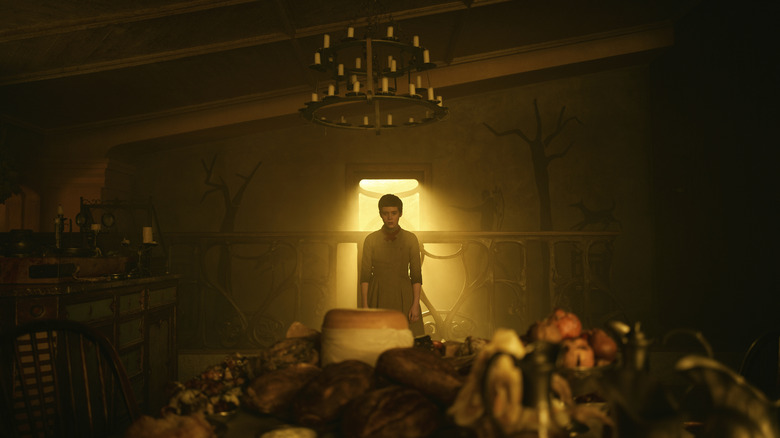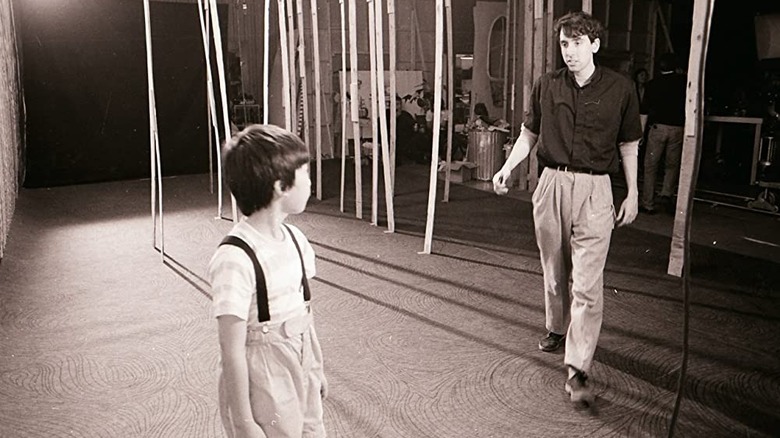Why Tim Burton's Hansel And Gretel Was Lost For So Long
When it comes to Tim Burton, fans are always dying to get their hands on his work. Known for his masterpieces "Beetlejuice," "Batman," "Edward Scissorhands," and the ever-popular "The Nightmare Before Christmas," anyone who's ever walked into a Spirit Halloween truly understands the cult-like worship devoted to Burton's major franchises. But Burton is far more than just the zany brains behind stop-motion, resurrected dogs, or unhinged bio-exorcists, and traces of what would become his signature style can be seen in his early work when he was a young man studying at the California Institute of the Arts. It is here where he would begin filming shorts which would eventually lead to him securing an apprenticeship with Disney that would go on to help launch his very impressive career.
While at Disney, Burton created a television special for the company that was set to air in 1983 on Halloween night. This special would be a re-telling of the famous Brothers Grimm fairytale, "Hansel and Gretel." The film premiered at 10:30 at night on the evening of October 31 and then was never seen again by the public, save for a few choice screenings at various museums like New York's Museum of Modern Art during their Tim Burton retrospective. It seems Burton's "Hansel and Gretel" was well on its way to becoming a lost film — fans of Burton often questioned its very existence — until it miraculously started appearing online years later.
So What's It About?
Like all of Burton's work, "Hansel and Gretel" takes plenty of dark twists and turns. The film, which can now be readily accessed online, is about 35 minutes long. During its original premiere, it was paired with Burton's other short film, "Vincent," and features an entirely Asian American cast — a vast departure from its original German source material. Instead, Burton's "Hansel and Gretel" has its roots steeped in Japanese culture. Hansel and Gretel's wicked stepmother is portrayed by a man, and his hair and makeup mimic the katsura or wig and kumadori makeup, all traditions found in Japanese kabuki theater. Many of the toys created by Hansel and Gretel's father are reminiscent of traditional Japanese children's toys and kaiju-like creations, turning the film into something more than just a retelling of a classic German tale.
The basic premise of Burton's "Hansel and Gretel" doesn't stray too far from the original story, however. Their wicked stepmother leads the two unsuspecting children into the forest where she promptly leaves them to meet their demise at the hands of a sugar-obsessed wicked witch. After an initial struggle, the kids prove themselves to be smarter than their candy-laden foe, tricking her into plunging headlong into the firey oven originally meant for them.
Burton plays up the German expressionism that he later becomes so well known for in the film's set design, and there are moments in the short 35-minute runtime where you can almost see the beginnings of Halloween Town with all of its curly hills and emaciated forests. The toys created by the children's father even feel like prototypes for the beloved vampire teddy and evil toy duck from "Nightmare." Even though it would be ten years before "The Nightmare Before Christmas" would hit the scene, it is clear that Burton was busy thinking about fantastical, creepy lands in which to set his future films.
Overall, "Hansel and Gretel" is a fascinating look into the beginnings of a brilliant filmmaker's career. So why, then, did it take so long for fans of Burton to be able to watch it?
The Mystery Explained
Artists are always thinking about and reflecting on their work, and oftentimes, things they created early on in their career are not the things they are most proud of accomplishing. It would appear that this is the very reason why it took so long for fans to be able to readily watch Burton's "Hansel and Gretel."
Purportedly, the short film was never given a wide release simply because Burton found the work to be embarrassing. While it's true that "Hansel and Gretel" is not Burton's best work, it is a fascinating piece of the Tim Burton puzzle. Now, thanks to its generous availability, it is something we can all look upon with fascination and awe, leaving the embarrassment behind as we pass through those sweet, candy-coated doors.

